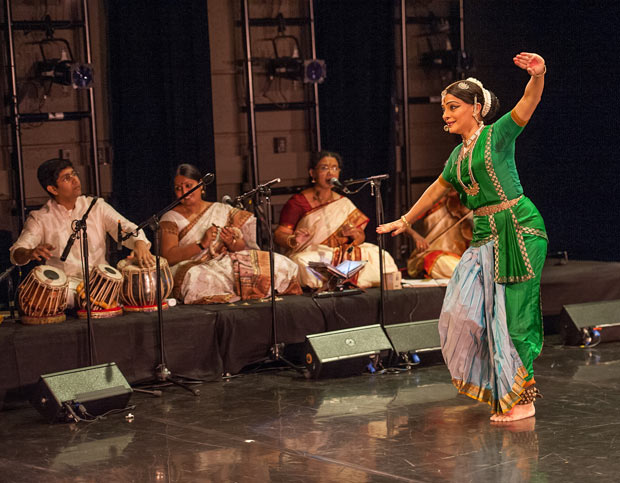
© Stephanie Berger. (Click image for larger version)
Dancing with the Eyes
Malavika Sarukkai
White Light Festival/The Spirit of the Body/Yatra—Seeking: Stithi Gati, Raas, The Bird Song, Laya
New York, Baryshnikov Arts Center
16 November 2012
www.malavikasarukkai.com
www.whitelightfestival.org
bacnyc.org
One of the minor side effects of Hurricane Sandy has been a series of adjustments to the city’s cultural calendar. Shows have been canceled, due to flooding or inaccessibility. (Unfortunately, some theatres, including The Kitchen, experienced serious damage that will take weeks or months to repair.) A few of these performances have been rescheduled, and this was the case with the White Light Festival’s presentation of the bharatanatyam dancer, Malavika Sarukkai, and her musical ensemble at the Baryshnikov Arts Center. From the looks of it many in the audience were not able to reschedule. It’s a shame, because it was a gripping evening of dance.
The Festival’s mission is to give proper place to the divine aspects of art. This year’s lineup included a concert of Charpentier motets by Les Arts Florissants, Georgian choral music by the Ensemble Basiani and Akram Khan’s dance, Vertical Road. All are meant to evoke some aspect of sublimity. In the case of Vertical Road the spiritual quest lies at the very heart of the work’s conception, perhaps too literally. But the meeting place of the spirit and the body is the natural context of bharatanatyam, a classical Indian dance whose roots lie in the Hindu temples of Southern India. When it was developed, more than two thousand years ago, its rituals were a form of devotion; later it became a court entertainment. In a way, as Sarukkai points out in her program notes, bharatanatyam’s adaptation to the stage in the nineteenth and twentieth centuries may be a way of saving it from the banality of becoming a titillating divertissement for the pleasure of kings. (This revalorisation of the art has a feminist aspect as well, as bharatanatyam is almost always performed by women.)
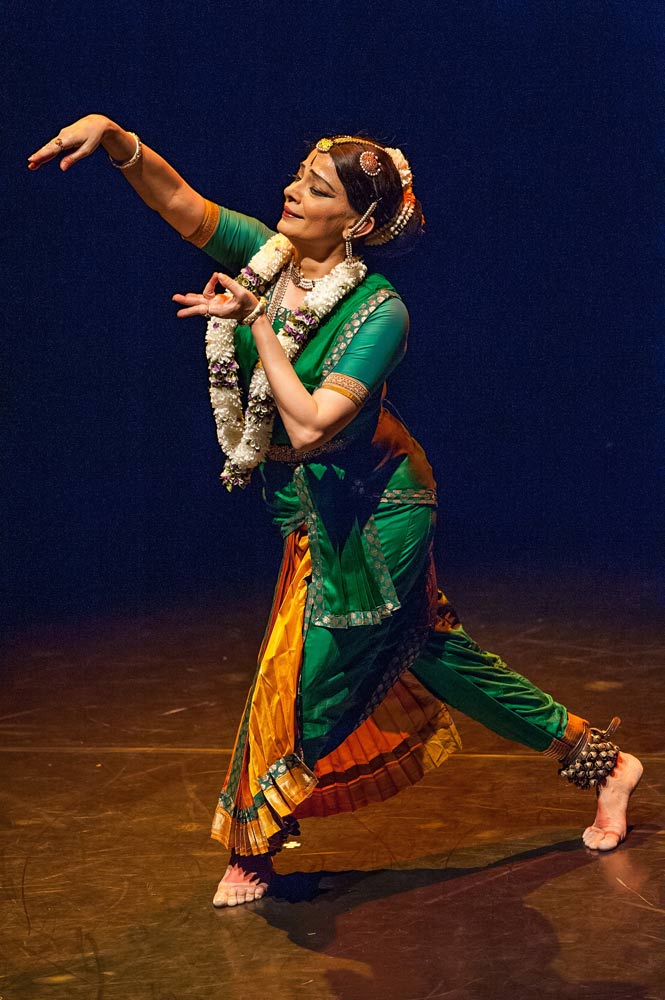
© Stephanie Berger. (Click image for larger version)
Sarukkai is an eminence in the world of Indian classical dance and, based on her program essay and the carefully-constructed pre-recorded introductions to each of her dances, she is an intelligent explicator of the art as well. But once she begins to dance, words become irrelevant: the clarity and detail of her dancing leaves no room for ambiguity or doubt. Like a master story-teller she is able to change registers and points of view in the course of a single solo, offering a variety of perspectives, from microscopic to sweepingly vast. She may not have the nimbleness or sheer pliancy of some younger dancers (judging from previous press accounts, she’s in her late forties or early fifties), but the sophistication of her dancing – and the complex structure of her choreographies – is awe-inspiring.
The ninety-minute evening was divided into four extraordinarily long solos, with almost no pause in between. Stithi Gati was a pure dance meditation on stillness and movement. Raas, a story dance inspired by Indian miniature paintings. The Bird Song, a visualization of a Tamil poem in which flight becomes a metaphor for spiritual pilgrimage. Laya (which translates as “merging”) is another visualization, this time inspired by the temple architecture, with its sumptuous exterior and quiet, meditative inner sanctum. Perhaps the most extraordinary, and certainly the most elaborate, piece was Raas, a multi-layered composition that ended with an ecstatic image of Sarukkai as Krishna playing his flute, spinning slowly, feet tapping gently, back to front. Like the paintings from which Sarukkai drew her inspiration, the dance began with a detailed scene, accompanied by chant-like singing (by Chitrambari Krishnakumar, one of three women in the musical ensemble). A woman busies herself with the tasks of the day, then is entranced by the sound of Krishna’s flute-playing. Its melody fills her body with a kind of burning, but graceful, sensuality; she saunters about the house, then begins to prepare herself for her dance with the god. With lilting gestures, she applies makeup to her eyes and a spot on her forehead, then checks her hair with not one but two mirrors. Every so often she pauses to hold a hand to her ear and a shimmering energy runs through her body. Eventually, she follows the sound into the forest, each towering tree clearly delineated by Sarukkai’s hands. Once in Krishna’s presence, she falls to her knees. Here, Sarukkai’s focus shifted: she became Krishna, divine, strong of body, all-knowing. Sarukkai was able to transform her movements from those of a flirtatious, sensual woman – all undulations and sinuous motion – to that of a god, harmonious, powerfully centered. (Later she shape-shifted again, rising high on the tips of her toes, seemingly stretching to twice her size, like a temple statue.) Her fingers trembled in the light. Then a miracle took place: Krishna multiplied. Sarukkai showed this in several ways: first, through the disbelief in her expressive eyes. (Sarukkai’s eyes are one of the wonders of the world.) Then, with her hands; she pointed to his manifestation here, and there, and there, until one could have sworn that the stage was full of dancing gods; and finally through a blur of steps encompassing the whole stage. Sarukkai’ magic lies in the ability to shift her point of view: first she embodies the dance, then she sees the dance, then she shows the dance, mainly with her hands, fluttering through space. By the end of this piece she had become the dance, in this case by reducing it to its most essential metaphor: an imaginary flute producing music.
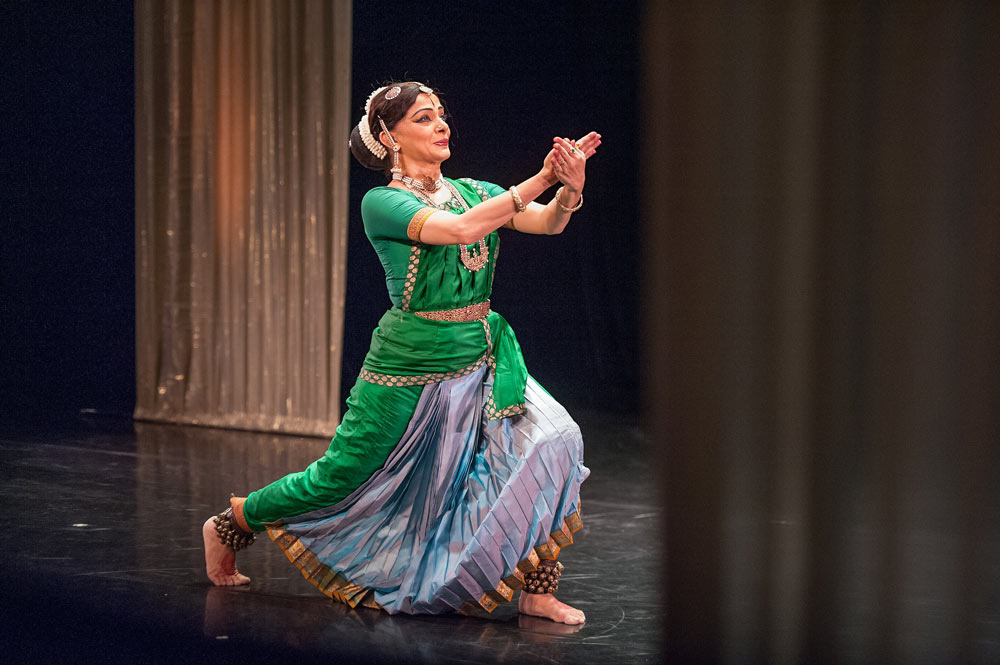
© Stephanie Berger. (Click image for larger version)
Also striking is Sarukkai’s ability to play with rhythm. All good classical Indian dancers are musical, but Sarukkai’s freedom and authoritativeness, coupled with her precision, is of a higher order. She gives off a sense of total mastery, easily shifting from one rhythmic pattern, accent, or tempo to another during her extended multi-part solos. Each section is part of a complicated progression, logical and ineluctable, toward an image that burns itself in one’s memory. Her movements also reflect shifts in the musical texture, exhibiting a vast range, from graceful to forceful, staccato to melodious and easygoing, curvaceous to angular and sharp. In The Bird Song she flirted with pure, almost contemporary movement (again, “showing” the sound of birdsong with her fingers). And then, in Laya, she gradually stripped down the movement to nothing, finally kneeling on the ground, folding herself into a tiny, almost insignificant bundle on the stage. It was an image of complete humility, a reminder of our smallness in the universe. But Sarukkai is anything but small.










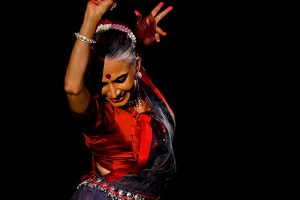

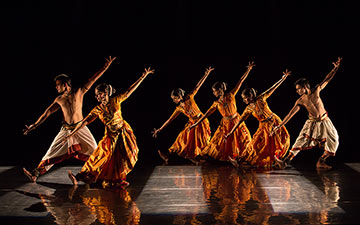
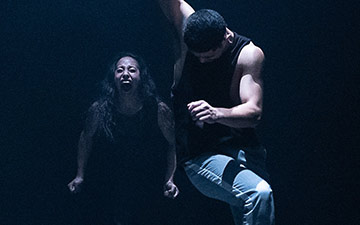


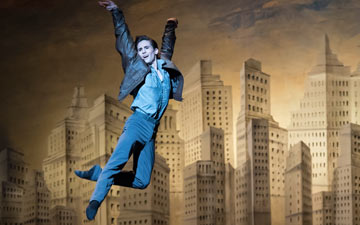
[…] The bharata natyam dancer Malavika Sarukkai came to the Baryshnikov Arts Center this week to present her rescheduled performances, part of the White Light Festival. She presented a remarkable evening of dance, divided into four extremely long, varied solos. She is an extraordinary story teller, able to bring out details with great clarity. You can read my review here. […]
Again Marina Harss writes with such eloquence about Indian dance. It seems
from her description that Sarukkai avoided the traditional Bharata Natyam recital order, but went straight into somethign very akin to the Varnam, the complex combination of pure dance, nrtta, and story telling , the province of padams.
I was particularly interested in her comments about the piece involving Krishna,
for the usual feminine subject is Radha, although there is a part of the Hindu
puranas which does describe Krishna replicated himself so that each gopi has
the illusion she is dancing with Krishna. Pretty magical guy!
It is really great to know such fine perception is available on Indian dance and I
am alerting friends in India regarding the review.